2021 Peugeot 308 ESP
[x] Cancel search: ESPPage 30 of 244
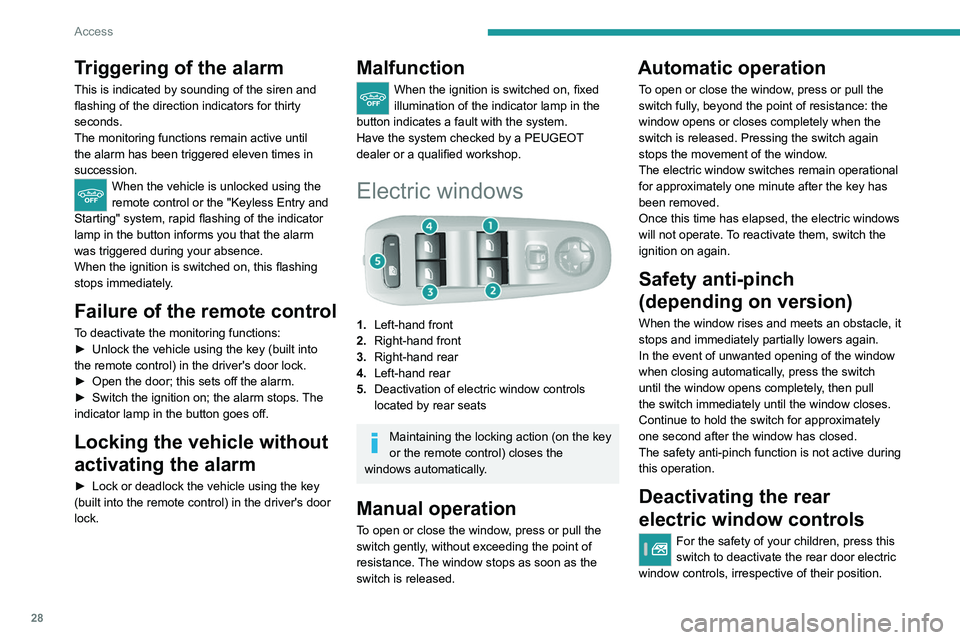
28
Access
If the indicator lamp is on, the rear controls are
deactivated.
If the indicator lamp is off, the rear controls are
activated.
Reinitialising the electric
windows
Following reconnection of the battery, the safety
anti-pinch function must be reinitialised.
The anti-pinch function is disabled during the
following operations:
– bring the window down completely, then bring
it back up. It will go up by a few centimetres with
each press. Perform the operation again until the
window is fully closed,
– continue to pull the switch upwards for at least
one second after reaching the window closed
position.
Always remove the key when leaving the vehicle, even for a short time.
In the event of contact (pinching) during
operation of the windows, you must reverse
the movement of the window. To do this,
press the switch concerned.
When operating the passenger electric
window controls, the driver must ensure
that no one is preventing the closing of the
windows.
The driver must ensure that passengers use
the electric windows correctly.
Be aware of children when operating the
windows.
Triggering of the alarm
This is indicated by sounding of the siren and
flashing of the direction indicators for thirty
seconds.
The monitoring functions remain active until
the alarm has been triggered eleven times in
succession.
When the vehicle is unlocked using the
remote control or the " Keyless Entry and
Starting" system, rapid flashing of the indicator
lamp in the button informs you that the alarm
was triggered during your absence.
When the ignition is switched on, this flashing
stops immediately
.
Failure of the remote control
To deactivate the monitoring functions:
► Unlock the vehicle using the key (built into
the remote control) in the driver's door lock.
►
Open the door; this sets off the alarm.
►
Switch the ignition on; the alarm stops.
The
indicator lamp in the button
goes off.
Locking the vehicle without
activating the alarm
► Lock or deadlock the vehicle using the key
(built into the remote control) in the driver's door
lock.
Malfunction
When the ignition is switched on, fixed
illumination of the indicator lamp in the
button indicates a fault with the system.
Have the system checked by a PEUGEOT
dealer or a qualified workshop.
Electric windows
1. Left-hand front
2. Right-hand front
3. Right-hand rear
4. Left-hand rear
5. Deactivation of electric window controls
located by rear seats
Maintaining the locking action (on the key
or the remote control) closes the
windows automatically.
Manual operation
To open or close the window, press or pull the
switch gently, without exceeding the point of
resistance. The window stops as soon as the
switch is released.
Automatic operation
To open or close the window, press or pull the
switch fully, beyond the point of resistance: the
window opens or closes completely when the
switch is released. Pressing the switch again
stops the movement of the window.
The electric window switches remain operational
for approximately one minute after the key has
been removed.
Once this time has elapsed, the electric windows
will not operate. To reactivate them, switch the
ignition on again.
Safety anti-pinch
(depending on version)
When the window rises and meets an obstacle, it
stops and immediately partially lowers again.
In the event of unwanted opening of the window
when closing automatically, press the switch
until the window opens completely, then pull
the switch immediately until the window closes.
Continue to hold the switch for approximately
one second after the window has closed.
The safety anti-pinch function is not active during
this operation.
Deactivating the rear
electric window controls
For the safety of your children, press this
switch to deactivate the rear door electric
window controls, irrespective of their position.
Page 34 of 244
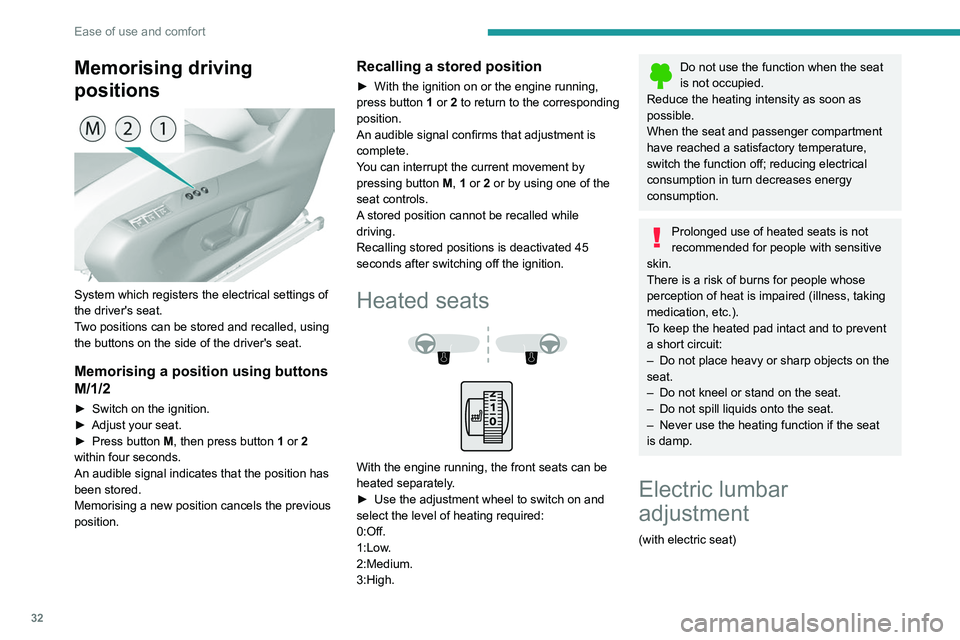
32
Ease of use and comfort
Memorising driving
positions
System which registers the electrical settings of
the driver's seat.
Two positions can be stored and recalled, using
the buttons on the side of the driver's seat.
Memorising a position using buttons
M/1/2
► Switch on the ignition.
► Adjust your seat.
►
Press button
M, then press button 1 or 2
within four seconds.
An audible signal indicates that the position has
been stored.
Memorising a new position cancels the previous
position.
Recalling a stored position
► With the ignition on or the engine running,
press button 1 or 2 to return to the corresponding
position.
An audible signal confirms that adjustment is
complete.
You can interrupt the current movement by
pressing button M, 1 or 2 or by using one of the
seat controls.
A stored position cannot be recalled while
driving.
Recalling stored positions is deactivated 45
seconds after switching off the ignition.
Heated seats
With the engine running, the front seats can be
heated separately.
►
Use the adjustment wheel to switch on and
select the level of heating required:
0:Off.
1:Low
.
2:Medium.
3:High.
Do not use the function when the seat
is not occupied.
Reduce the heating intensity as soon as
possible.
When the seat and passenger compartment
have reached a satisfactory temperature,
switch the function off; reducing electrical
consumption in turn decreases energy
consumption.
Prolonged use of heated seats is not
recommended for people with sensitive
skin.
There is a risk of burns for people whose
perception of heat is impaired (illness, taking
medication, etc.).
To keep the heated pad intact and to prevent
a short circuit:
–
Do not place heavy or sharp objects on the
seat.
–
Do not kneel or stand on the seat.
–
Do not spill liquids onto the seat.
–
Never use the heating function if the seat
is damp.
Electric lumbar
adjustment
(with electric seat)
Page 36 of 244

34
Ease of use and comfort
They can also be folded for parking in narrow
spaces.
Demisting - Defrosting
Demisting-defrosting of the door mirrors
operates with the engine running, by
switching on the heated rear screen.
For more information on Demisting and
defrosting the rear screen, refer to the
associated section.
Adjustment
► Move control A to the right or to the left to
select the corresponding mirror.
►
Move control
B in any of the four directions
to adjust.
►
Return control A
to the central position.
As a safety measure, the mirrors should be adjusted to reduce "blind spots".
Objects that you see in the mirrors are in fact
closer than they appear.
Take this into account in order to correctly
judge the distance of vehicles approaching
from behind.
Folding
► From outside: lock the vehicle using the
electronic key or the " Keyless Entry and Starting"
system.
►
From inside: with the ignition on, pull the
control
A in the central position rearwards.
If the mirrors are folded using control A,
they will not unfold when the vehicle is
unlocked. Pull again on control A.
Unfolding
► From outside: unlock the vehicle using the
electronic key or the " Keyless Entry and Starting"
system.
►
From inside: with the ignition on, pull the
control
A in the central position rearwards.
The folding and unfolding of the door mirrors using the remote control can be
deactivated by a PEUGEOT dealer or a
qualified workshop.
If necessary, the mirrors can be folded
manually.
Rear view mirror
Equipped with an anti-dazzle system, which
darkens the mirror glass and reduces the
nuisance to the driver caused by the sun,
headlights of other vehicles, etc.
Manual model
Adjustment
► Adjust the mirror so that the mirror is directed
correctly in the "day" position.
Day / night position
► Pull the lever to change to the "night" anti-
dazzle position.
►
Push the lever to change to the normal "day"
position.
Automatic "electrochrome" model
This system automatically and progressively
changes between day and night use by means
of a sensor measuring the light coming from the
rear of the vehicle.
In order to ensure optimum visibility
during your manoeuvres, the mirror
Page 37 of 244
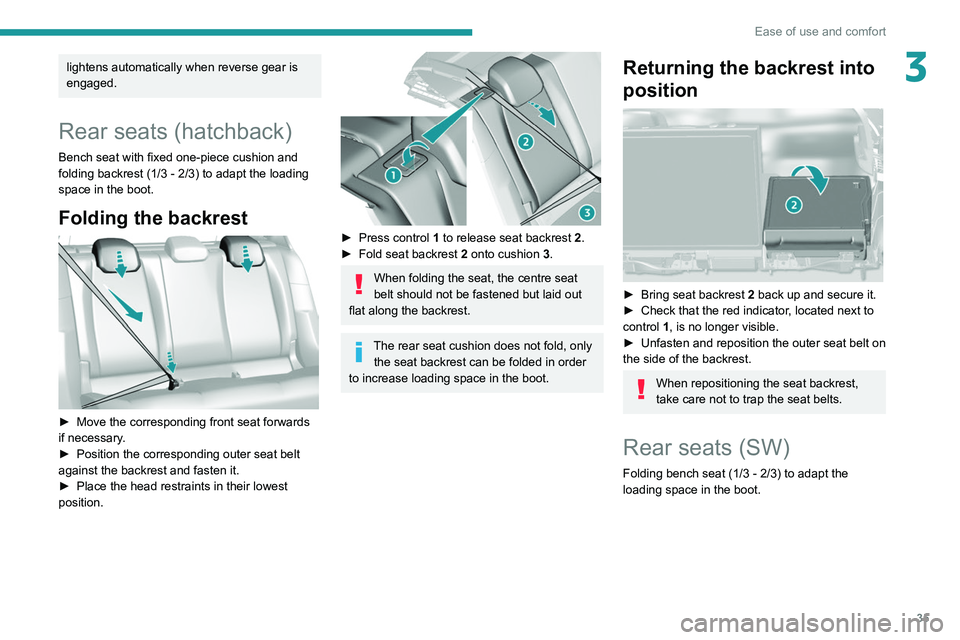
35
Ease of use and comfort
3lightens automatically when reverse gear is
engaged.
Rear seats (hatchback)
Bench seat with fixed one-piece cushion and
folding backrest (1/3 - 2/3) to adapt the loading
space in the boot.
Folding the backrest
► Move the corresponding front seat forwards
if necessary .
►
Position the corresponding outer seat belt
against the backrest and fasten it.
►
Place the head restraints in their lowest
position.
► Press control 1 to release seat backrest 2.
► Fold seat backrest 2 onto cushion 3.
When folding the seat, the centre seat
belt should not be fastened but laid out
flat along the backrest.
The rear seat cushion does not fold, only the seat backrest can be folded in order
to increase loading space in the boot.
Returning the backrest into
position
► Bring seat backrest 2 back up and secure it.
► Check that the red indicator , located next to
control 1, is no longer visible.
►
Unfasten and reposition the outer seat belt on
the side of the backrest.
When repositioning the seat backrest,
take care not to trap the seat belts.
Rear seats (SW)
Folding bench seat (1/3 - 2/3) to adapt the
loading space in the boot.
Page 38 of 244
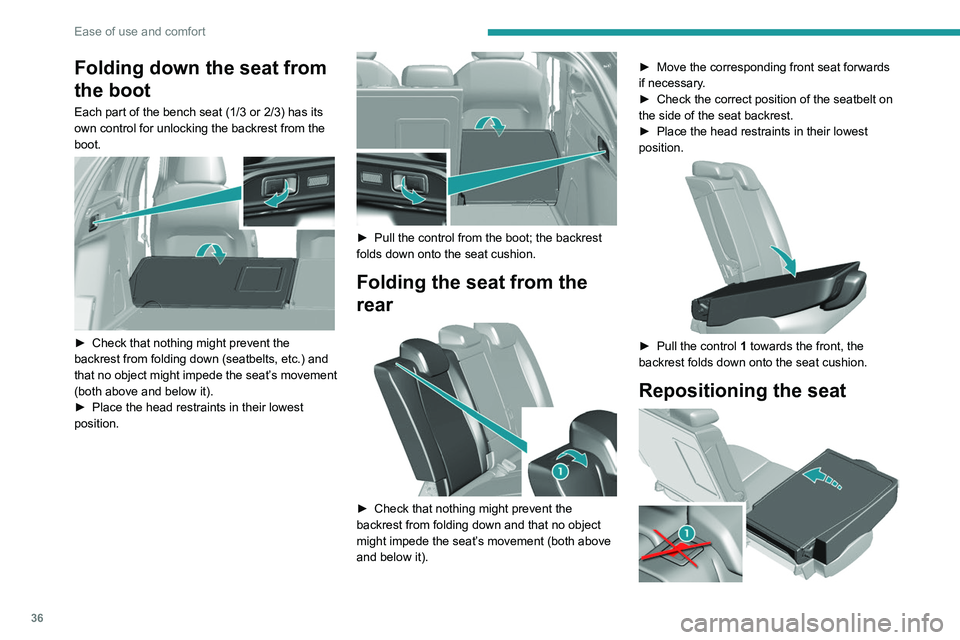
36
Ease of use and comfort
Folding down the seat from
the boot
Each part of the bench seat (1/3 or 2/3) has its
own control for unlocking the backrest from the
boot.
► Check that nothing might prevent the
backrest from folding down (seatbelts, etc.) and
that
no object might impede the seat’s movement
(both above and below it).
►
Place the head restraints in their lowest
position.
► Pull the control from the boot; the backrest
folds down onto the seat cushion.
Folding the seat from the
rear
► Check that nothing might prevent the
backrest from folding down and that no object
might
impede the seat’s movement (both above
and below it). ►
Move the corresponding front seat forwards
if necessary
.
►
Check the correct position of the seatbelt on
the side of the seat backrest.
►
Place the head restraints in their lowest
position.
► Pull the control 1 towards the front, the
backrest folds down onto the seat cushion.
Repositioning the seat
Page 42 of 244
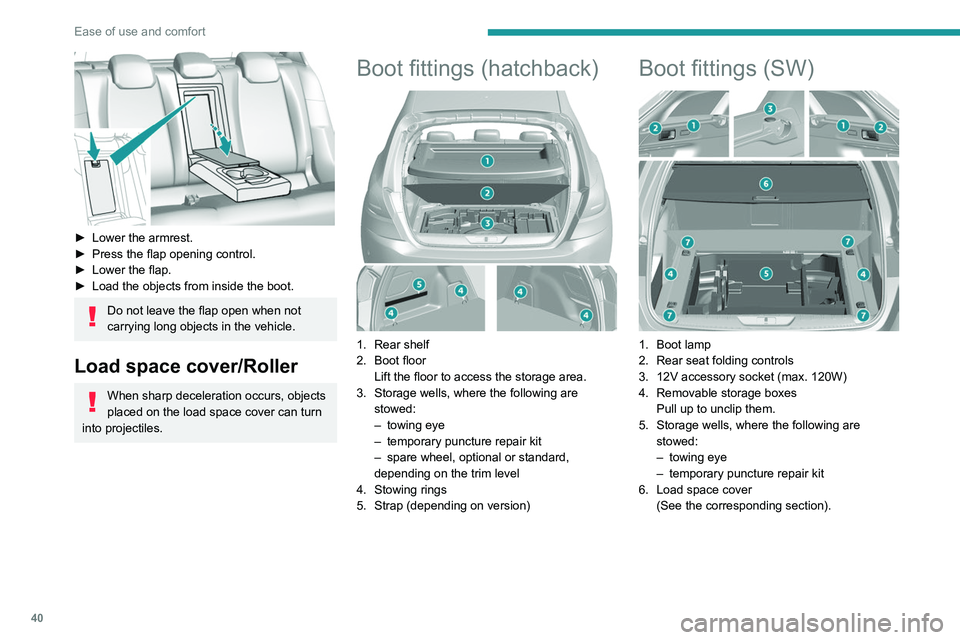
40
Ease of use and comfort
► Lower the armrest.
► Press the flap opening control.
►
Lower the flap.
►
Load the objects from inside the boot.
Do not leave the flap open when not
carrying long objects in the vehicle.
Load space cover/Roller
When sharp deceleration occurs, objects
placed on the load space cover can turn
into projectiles.
Boot fittings (hatchback)
1. Rear shelf
2. Boot floor
Lift the floor to access the storage area.
3. Storage wells, where the following are stowed:
–
towing eye
–
temporary puncture repair kit
–
spare wheel, optional or standard,
depending on the trim level
4. Stowing rings
5. Strap (depending on version)
Boot fittings (SW)
1. Boot lamp
2. Rear seat folding controls
3. 12V accessory socket (max. 120W)
4. Removable storage boxes Pull up to unclip them.
5. Storage wells, where the following are stowed:
–
towing eye
–
temporary puncture repair kit
6. Load space cover (See the corresponding section).
Page 44 of 244
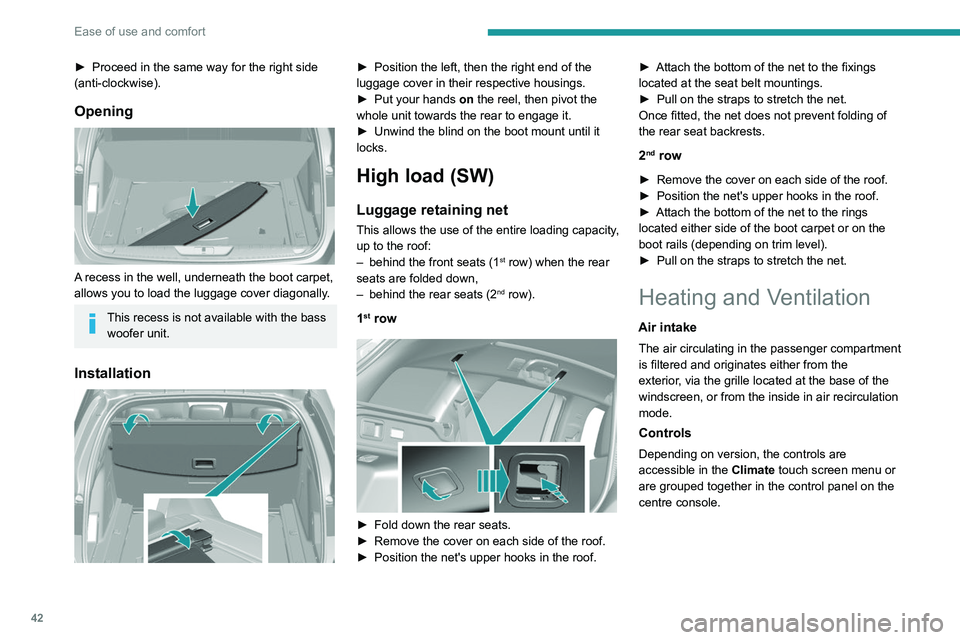
42
Ease of use and comfort
► Proceed in the same way for the right side
(anti-clockwise).
Opening
A recess in the well, underneath the boot carpet,
allows you to load the luggage cover diagonally.
This recess is not available with the bass woofer unit.
Installation
► Position the left, then the right end of the
luggage cover in their respective housings.
►
Put your hands
on the reel, then pivot the
whole unit towards the rear to engage it.
►
Unwind the blind on the boot mount until it
locks.
High load (SW)
Luggage retaining net
This allows the use of the entire loading capacity,
up to the roof:
–
behind the front seats (1st row) when the rear
seats are folded down,
–
behind the rear seats (2nd row).
1st row
► Fold down the rear seats.
► Remove the cover on each side of the roof.
►
Position the net's upper hooks in the roof. ►
Attach the bottom of the net to the fixings
located at the seat belt mountings.
►
Pull on the straps to stretch the net.
Once fitted, the net does not prevent folding of
the rear seat backrests.
2nd row
► Remove the cover on each side of the roof.
► Position the net's upper hooks in the roof.
►
Attach the bottom of the net to the rings
located either side of the boot carpet or on the
boot rails (depending on trim level).
►
Pull on the straps to stretch the net.
Heating and Ventilation
Air intake
The air circulating in the passenger compartment
is filtered and originates either from the
exterior, via the grille located at the base of the
windscreen, or from the inside in air recirculation
mode.
Controls
Depending on version, the controls are
accessible in the Climate touch screen menu or
are grouped together in the control panel on the
centre console.
Page 45 of 244

43
Ease of use and comfort
3Air distribution
1.Windscreen demisting/defrosting vents
2. Front side window demisting/defrosting vents
3. Adjustable and closable side air vents
4. Adjustable and closable central air vents
5. Air outlets to the front footwells
6. Air outlets to the rear footwells
Advice
Using the ventilation and air
conditioning system
►
T
o ensure that air is distributed evenly,
keep the external air intake grilles at the base
of the windscreen, the nozzles, the vents, the
air outlets and the air extractor in the boot
free from obstructions.
►
Do not cover the sunshine sensor located
on the dashboard; this sensor is used to
regulate the automatic air conditioning
system.
► Operate the air conditioning system for at
least 5 to 10 minutes once or twice a month to
keep it in perfect working order
.
►
If the system does not produce cold air
,
switch it off and contact a PEUGEOT dealer
or a qualified workshop.
When towing the maximum load on a steep
gradient in high temperatures, switching off
the air conditioning increases the available
engine power, enhancing the towing capacity.
Avoid driving for too long with the ventilation off or with prolonged operation
of interior air recirculation. Risk of misting and
deterioration of the air quality!
If the interior temperature is very high
after the vehicle has stood for a long
time in the sunshine, air the passenger
compartment for a few moments.
Put the air flow control at a setting high
enough to quickly change the air in the
passenger compartment.
Condensation created by the air
conditioning results in a discharge of
water underneath the vehicle. This is perfectly
normal.
Servicing the ventilation and air
conditioning system
►
Ensure that the passenger compartment
filter is in good condition and have the filter
elements replaced regularly
.
We recommend using a composite passenger
compartment filter. Thanks to its special active
additive, this type of filter helps to purify the
air breathed by the occupants and keep the
passenger compartment clean (by reducing
allergic symptoms, unpleasant odours and
greasy deposits).
►
T
o ensure correct operation of the
air conditioning system, have it checked
according to the recommendations in the
Maintenance and Warranty Guide.
Stop & Start
The heating and air conditioning systems
only operate when the engine is running.
Temporarily deactivate the Stop & Start
system to maintain a comfortable temperature
in the passenger compartment.
For more information on the Stop & Start,
refer to the corresponding section.
Manual air conditioning
The manual air conditioning system operates
with the engine running.